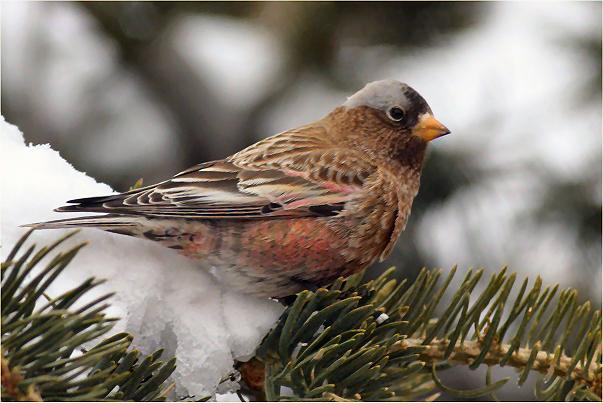
Location: Sandia Crest, Albuqerque, NM
Date: 2004-11-27
Lens: Canon 400mm F5.6

 Gray-Crowned Rosy-Finch
Leucosticte tephrocotis
Gray-Crowned Rosy-Finch
Leucosticte tephrocotis
 Description
DescriptionDuring breeding, both the male and the female rosy-finches grow a pair of "cheek pouches" (called "gular pouches"), opening from the floor of the mouth, which they use to carry large amounts food to the growing young. This finch primarily feeds on plant seeds and insects. Preferring the barren landscape and snow of the high elevations, this finch breeds in some of the most inhospitable locations. The ancestors of the rosy-finches came from Asia. The three rosy-finch species were once considered a single species.
Brown back, and underparts. Black forehead and throat. Pale gray hindcrown patch extending from eye to nape. There is some variability in the amount of grey on the head. Rosy-pink belly, undertail coverts, rump and wing feather edges. Forked tail. Sexes similar, except female is duller in color. First winter birds have a yellowish bill with a dark tip and have duller looking feathers. Juveniles are indistinguishable from other Rosy-Finch species. There is variability in the amount of grey on the head. Coastal species have a gray face, while interior has brown. 5.75 to 6.75 inches in length.
Alpine tundra and high elevation snowfields in winter. Lower elevation mountain meadows and open areas during summer. Often found in mixed-species flocks.
 Nesting
Nesting3-5 white eggs. The eggs have a 12-14 day incubation period. Fledging occurs in 16-22 days. The nest is a bulky open cup of moss, grass, fur and feathers built in a rock cavity on the ground. The female incubates the eggs.